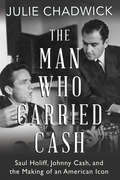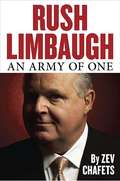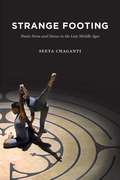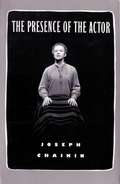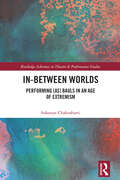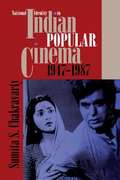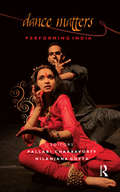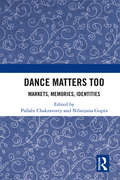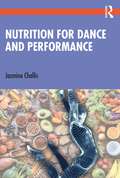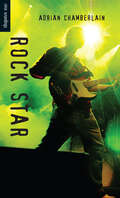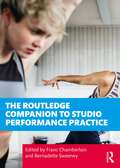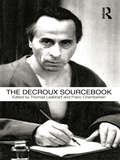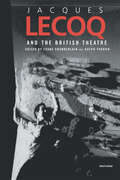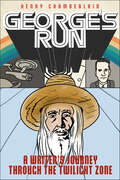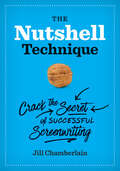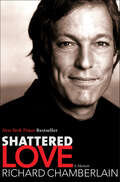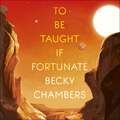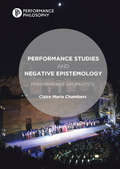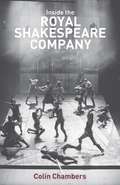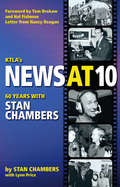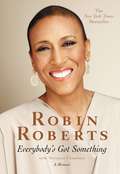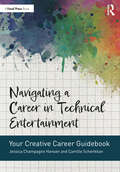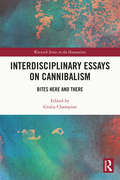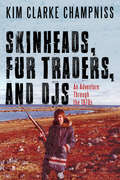- Table View
- List View
The Man Who Carried Cash: Saul Holiff, Johnny Cash, and the Making of an American Icon
by Julie ChadwickThe unlikely, rocky relationship between an American country superstar and his straightlaced Canadian manager. Before there was Johnny and June, there was Johnny and Saul. The Man Who Carried Cash chronicles a relationship that was both volatile and affectionate between Johnny Cash and his manager, Saul Holiff. From roadside taverns to the roaring crowds at Madison Square Garden, from wrecked cars and jail cells all the way to the White House, the story of Johnny and Saul is a portrait of two men from different worlds who were more alike than either cared to admit. Saul handled the bookings and the no-shows, the divorce and the record deals, drugs, overdoses, and arrests. He was there for the absolute worst of times, but also for the best: Carnegie Hall, Folsom Prison, “A Boy Named Sue,” and Cash’s hit television series. But in 1973, at the zenith of Cash’s career, Saul quit. Until now, no one knew why.
Rush Limbaugh: An Army of One
by Zev Chafets"I know the liberals call you 'the most dangerous man in America,' but don't worry about it, they used to say the same thing about me. Keep up the good work. " -Ronald Reagan in a letter to Rush Limbaugh, December 11, 1992. Do you remember your first time? People tend to remember the moment they first heard The Rush Limbaugh Show on the radio. For Zev Chafets, it was in a car in Detroit, driving down Woodward Avenue. Limbaugh's braggadocio, the outrageous satire, the slaughtering of liberal sacred cows performed with the verve of a rock-n-roll DJ-it seemed fresh, funny and completely subversive. "They're never going to let this guy stay on the air," he thought. Almost two decades later Chafets met Rush for the first time, at Limbaugh's rarely visited "Southern Command. " They spent hours together talking on the record about politics, sports, music, show business, religion and modern American history. Rush opened his home and his world, introducing Chafets to his family, closest friends, even his psychologist. The result was an acclaimed cover-story profile of Limbaugh in The New York Times Magazine. But there was much more to say, especially after Limbaugh became Public Enemy Number One of the Obama Administration. At first Limbaugh resisted the idea of a full-length portrait, but he eventually invited Chafets back to Florida and exchanged more than a hundred emails full of his personal history, thoughts, fears and ambitions. What has emerged is an uniquely personal look at the man who is not only the most popular voice on the radio, but the leader of the conservative movement and one of the most influential figures in the Republican Party. While Limbaugh's public persona is instantly recognizable, his background and private life are often misunderstood. Even devoted Dittoheads will find there's a lot they don't know about the self-described "harmless little fuzzball" who has, over the years, taken on the giants of the mainstream media and the Democratic Party-from Bill and Hillary Clinton to Barack Obama-with "half his brain tied behind his back, just to make it fair. " Chafets paints a compelling portrait of Limbaugh as a master entertainer, a public intellectual, a political force, and a fascinating man.
Strange Footing: Poetic Form and Dance in the Late Middle Ages
by Seeta ChagantiFor premodern audiences, poetic form did not exist solely as meter, stanzas, or rhyme scheme. Rather, the form of a poem emerged as an experience, one generated when an audience immersed in a culture of dance encountered a poetic text. Exploring the complex relationship between medieval dance and medieval poetry, Strange Footing argues that the intersection of texts and dance produced an experience of poetic form based in disorientation, asymmetry, and even misstep. Medieval dance guided audiences to approach poetry not in terms of the body’s regular marking of time and space, but rather in the irregular and surprising forces of virtual motion around, ahead of, and behind the dancing body. Reading medieval poems through artworks, paintings, and sculptures depicting dance, Seeta Chaganti illuminates texts that have long eluded our full understanding, inviting us to inhabit their strange footings askew of conventional space and time. Strange Footing deploys the motion of dance to change how we read medieval poetry, generating a new theory of poetic form for medieval studies and beyond.
The Presence of the Actor
by Joseph ChaikinChaikin, who directed the celebrated Open Theater in the '60s, kindled an emphasis on communal playmaking whose impact is still evident today. This conversational review of his efforts details his methods and reveals the struggles involved in the creation of some of the most exciting theatre of our time.
In-Between Worlds: Performing [as] Bauls in an Age of Extremism (Routledge Advances in Theatre & Performance Studies)
by Sukanya ChakrabartiThis book examines the performance of Bauls ‘folk’ performers from Bengal, in the context of a rapidly globalizing Indian economy and against the backdrop of extreme nationalistic discourses. Recognizing their scope beyond the musical and cultural realm, Sukanya Chakrabarti engages in discussing the subversive and transformational potency of Bauls and their performances. In-Between Worlds argues that the Bauls through their musical, spiritual, and cultural performances offer ‘joy’ and ‘spirituality,’ thus making space for what Dr. Ambedkar in his famous 1942 speech had identified as ‘reclamation of human personality’. Chakrabarti destabilizes the category of ‘folk’ as a fixed classification or an origin point, and fractures homogeneous historical representations of the Baul as a ‘folk’ performer and a wandering mendicant exposing the complex heterogeneity that characterizes this group. Establishing ‘folk-ness’ as a performance category, and ‘folk festivals’ as sites of performing ‘folk-ness,’ contributing to a heritage industry that thrives on imagined and recreated nostalgia, Chakrabarti examines different sites that produce varied performative identities of Bauls, probing the limits of such categories while simultaneously advocating for polyvocality and multifocality. While this project has grounded itself firmly in performance studies, it has borrowed extensively from fields of postcolonial studies and subaltern histories, literature, ethnography and ethnomusicology, and cosmopolitan studies.
National Identity in Indian Popular Cinema, 1947-1987
by Sumita S. ChakravartyAlthough Indian popular cinema has a long history and is familiar to audiences around the world, it has rarely been systematically studied. This book offers the first detailed account of the popular film as it has grown and changed during the tumultuous decades of Indian nationhood. The study focuses on the cinema's characteristic forms, its range of meanings and pleasures, and, above all, its ideological construction of Indian national identity.<P><P>Informed by theoretical developments in film theory, cultural studies, postcolonial discourse, and "Third World" cinema, the book identifies the major genres and movements within Bombay cinema since Independence and uses them to enter larger cultural debates about questions of identity, authenticity, citizenship, and collectivity. Chakravarty examines numerous films of the period, including Guide (Vijay Anand, 1965), Shri 420 [The gentleman cheat] (Raj Kapoor, 1955), and Bhumika [The role] (Shyam Benegal, 1977). She shows how "imperso-nation," played out in masquerade and disguise, has characterized the representation of national identity in popular films, so that concerns and conflicts over class, communal, and regional differences are obsessively evoked, explored, and neutralized.
Dance Matters: Performing India on Local and Global Stages
by Pallabi Chakravorty Nilanjana GuptaThis volume presents a multidisciplinary perspective on dance scholarship and practice as they have evolved in India and its diaspora, outlining how dance histories have been written and re-written, how aesthetic and pedagogical conventions have changed and are changing, and how politico-economic shifts have shaped Indian dance and its negotiation with modernity.. Written by eminent and emergent scholars and practitioners of Indian dance, the articles make dance a foundational socio-cultural and aesthetic phenomena that reflects and impacts upon various cultural intercourses -- from art and architecture to popular culture, and social justice issues. They also highlight the interplay of various frameworks: global, national, and local/indigenous for studying these diverse performance contexts, using dance as a critical lens to analyse current debates on nationalism, transnationalism, gender and sexuality, and postcolonial politics. At the performace level, some articles question the accepted divisions of Indian dance (‘classical’, ‘folk’, and ‘popular’) and critique the dominant values associated with classical dance forms. Finally, the book brings together both experiential and objective dimensions of bodily knowledge through dance.
Dance Matters Too: Markets, Memories, Identities
by Pallabi Chakravorty Nilanjana GuptaDance Matters Too: Markets, Memories, Identities is a rich intellectual contribution to the growing field of dance studies in India. It forges new avenues of scholarly inquiry and critical engagement and opens the field in innovative ways. This volume builds on Dance Matters (2009), which mapped the interdisciplinary breadth of the field. The chapters presented here continue to underline the uniqueness of a field that is a blend of critical scholarship on aesthetics and performance with the humanities and social sciences. Including diverse material, analytical approaches and perspectives from scholars and practitioners, this multidimensional volume explores debates on dance preservation and tradition in globalizing India, multimedia choreographies and the circulation of dance via electronic media, embodiment and memory, power, democracy and bourgeoning markets, classification and censorship, and corporatization and Bollywood. This tour de force will appeal to those in dance and performance studies, cultural studies, sociology as well as to readers interested in tradition, modernity, gender and globalization.
Nutrition for Dance and Performance
by Jasmine ChallisNutrition for Dance and Performance is the first complete textbook written by an experienced dietitian specialising in the field of dance nutrition. It seeks to provide both dancers-in-training and instructors with practical advice on dance nutrition for health and performance. It is also highly relevant for dance professionals. With an in-depth and extensive coverage on all nutrition topics relevant to dancers, this book covers nutrition for the scenarios dancers face, including day-to-day training and rehearsals, peak performance, injuries, immunonutrition, nutrition and stress management. Information is included on topics applicable to individual dancers including advice for dancers with Type 1 diabetes and clinical conditions relating to gut health. The book guides the reader through the macronutrients making up the diet, their chemical structure and their role in health and optimal performance. Readers are shown how to estimate energy and nutrient needs based on their schedule, type of dance undertaken and personal goals before considering the practical aspects of dance nutrition; from nutrition planning to dietary supplements, strategies for assessing the need to alter body composition and guidance on undertaking health-focused changes. Nutrition for Dance and Performance combines and condenses the author’s knowledge and many years of experience working in the dance industry to translate nutrition science into a practical guide. Bringing together the latest research in dance science and nutrition, this book aims to be a trusted reference and practical textbook for students of Dance, Dance Nutrition, Dance Performance, Sport Nutrition and Sport Science more generally as well as for those training in the dance industry, dance teachers and professionals. Jasmine Challis is a freelance Registered Nutritionist (UK Association for Nutrition) and Dietitian registered with the Health Care Professions Council, and is on the UK Sport and Exercise Nutrition Register (SENR) focusing on dance. She completed an MRes in Sport and Exercise Science in 2018. She is on the Dance Medicine and Science Expert Panel for One Dance UK and is on the board of The Bridge Dance Project. She has worked across the dance field for over 30 years giving talks, running workshops and providing 1:1 sessions for dancers and dance students.
Rock Star (Orca Soundings)
by Adrian ChamberlainStruggling at home and at school, Duncan decides to try out for a local rock band. He plays the bass in the school orchestra, but it is a long way from band camp to rock star. Joining a heavy-metal band, he tries to fit in, dumping his old friends and trying to walk the walk. When his dad's new girlfriend starts to teach him about real rock music and introduces him to her musician brother, Duncan discovers that there is more to being a guitar hero than playing in a heavy-metal band.
The Routledge Companion to Studio Performance Practice
by Franc ChamberlainThe Routledge Companion to Studio Performance Practice is a unique, indispensable guide to the training methods of the world’s key theatre practitioners. Compiling the practical work outlined in the popular Routledge Performance Practitioners series of guidebooks, each set of exercises has been edited and contextualised by an expert in that particular approach. Each chapter provides a taster of one practitioner’s work, answering the same key questions: ‘How did this artist work? How can I begin to put my understanding of this to practical use?’ Newly written chapter introductions put the exercises in context, explaining how they fit into the wider methods and philosophy of the practitioner in question. All 21 volumes in the original series are represented in this volume.
The Decroux Sourcebook
by Franc Chamberlain Thomas LeabhartThe Decroux Sourcebook is the first point of reference for any student of the ‘hidden master’ of twentieth century theatre. This book collates a wealth of key material on Etienne Decroux, including: an English translation of Patrice Pezin’s ‘Imaginary Interview’, in which Decroux discusses mime’s place in the theatre. previously unpublished articles by Decroux from France’s Bibiothèque Nationale. essays from Decroux’s fellow innovators Eugenio Barba and Edward Gordon Craig, explaining the synthesis of theory and practice in his work. Etienne Decroux’s pioneering work in physical theatre is here richly illustrated not only by a library of source material, but also with a gallery of images following his life, work and influences. The Decroux Sourcebook is an ideal companion to Thomas Leabhart’s Etienne Decroux in the Routledge Performance Practitioners series, offering key primary and secondary resources to those conducting research at all levels.
Jacques Lecoq and the British Theatre
by Franc Chamberlain Ralph YarrowJacques Lecoq and the British Theatre brings together the first collection of essays in English to focus on Lecoq's school of mime and physical theatre. For four decades, at his school in Paris, Jacques Lecoq trained performers from all over the world and effected a quiet evolution in the theatre. The work of such highly successful Lecoq graduates as Theatre de Complicite (The Winter's Tale with the Royal Shakespeare Company and The Visit, The Street of Crocodiles and The Causcasian Chalk Circle with the Royal National Theatre) has brought Lecoq's work to the attention of mainstream critics and audiences in Britain. Yet Complicte is just the tip of the Iceberg. The contributors to this volume, most of them engaged in applying Lecoq's work, chart some of the diverse ways in which it has had an impact on our conceptions of mime, physical theatre, actor training, devising street theatre and interculturalism. This lively - even provocative - collection of essays focuses academic debate and raises awareness of the impact of Lecoq's work in Britain today.
George's Run: A Writer's Journey through the Twilight Zone
by Henry ChamberlainGeorge Clayton Johnson was an up-and-coming short story writer who broke into Hollywood in a big way when he co-wrote the screenplay for Ocean’s Eleven. More legendary works followed, including Logan’s Run and classic scripts for shows like The Twilight Zone and Star Trek. In the meantime, he forged friendships with some of the era’s most visionary science fiction writers, including Ray Bradbury, Theodore Sturgeon, Richard Matheson, and Rod Serling. Later in life, Johnson befriended comics journalist and artist Henry Chamberlain, and the two had long chats about his amazing life and career. Now Chamberlain pays tribute to his late friend in the graphic novel George’s Run, which brings Johnson’s creative milieu to life in vividly illustrated color panels. The result feels less like reading a conventional biography and more like sitting in on an intimate conversation between friends as they recollect key moments in pop culture history, as well as the colorful band of writers known as the “Rat Pack of Science Fiction.”
The Nutshell Technique: Crack the Secret of Successful Screenwriting
by Jill ChamberlainA veteran Hollywood script consultant unlocks the secrets of storytelling in this &“clever, fresh way of analyzing structure&” (Creative Screenwriting magazine). Veteran script consultant Jill Chamberlain knows that most first-time screenwriters don&’t understand how to tell a story. These writers may have snappy dialogue, interesting characters, and clever plot devices—but what they deliver isn&’t a story. It&’s a situation. In order to explain the difference, Chamberlain created the Nutshell Technique, a method whereby writers identify eight dynamic, interconnected elements that are required to successfully tell a story. In this book, Chamberlain uses easy-to-follow diagrams (&“nutshells&”) to explain how the Nutshell Technique can make or break a film script. She takes readers step-by-step through thirty classic and contemporary movies, showing how such dissimilar screenplays as Casablanca, Chinatown, Pulp Fiction, Little Miss Sunshine, Juno, and Argo all have the same system working behind the scenes. She then teaches readers how to apply these principles to their own screenwriting.
The Nutshell Technique: Crack the Secret of Successful Screenwriting
by Jill ChamberlainA veteran Hollywood script consultant unlocks the secrets of storytelling in this &“clever, fresh way of analyzing structure&” (Creative Screenwriting magazine). Veteran script consultant Jill Chamberlain knows that most first-time screenwriters don&’t understand how to tell a story. These writers may have snappy dialogue, interesting characters, and clever plot devices—but what they deliver isn&’t a story. It&’s a situation. In order to explain the difference, Chamberlain created the Nutshell Technique, a method whereby writers identify eight dynamic, interconnected elements that are required to successfully tell a story. In this book, Chamberlain uses easy-to-follow diagrams (&“nutshells&”) to explain how the Nutshell Technique can make or break a film script. She takes readers step-by-step through thirty classic and contemporary movies, showing how such dissimilar screenplays as Casablanca, Chinatown, Pulp Fiction, Little Miss Sunshine, Juno, and Argo all have the same system working behind the scenes. She then teaches readers how to apply these principles to their own screenwriting.
Shattered Love: A Memoir
by Richard ChamberlainIn Shattered Love, Richard Chamberlain poignantly recounts his lifelong struggle to find happiness. Tracing a fascinating path over his meteoric rise to success, he chronicles his struggle to come to terms with his own imperfections, his growing desire to be honest about his sexual orientation, and his yearning to live with an open heart. And along the way he imparts the lessons he has learned about overcoming our own self–imposed obstacles to happiness.
To Be Taught, If Fortunate: A Novella
by Becky ChambersIn the future, instead of terraforming planets to sustain human life, explorers of the galaxy transform themselves.*FROM THE SUNDAY TIMES BESTSELLING AUTHOR* At the turn of the twenty-second century, scientists make a breakthrough in human spaceflight. Through a revolutionary method known as somaforming, astronauts can survive in hostile environments off Earth using synthetic biological supplementations. They can produce antifreeze in sub-zero temperatures, absorb radiation and convert it for food, and conveniently adjust to the pull of different gravitational forces. With the fragility of the body no longer a limiting factor, human beings are at last able to explore neighbouring exoplanets long suspected to harbour life.Ariadne is one such explorer. On a mission to ecologically survey four habitable worlds fifteen light-years from Earth, she and her fellow crewmates sleep while in transit, and wake each time with different features. But as they shift through both form and time, life back on Earth has also changed. Faced with the possibility of returning to a planet that has forgotten those who have left, Ariadne begins to chronicle the wonders and dangers of her journey, in the hope that someone back home might still be listening.(P) 2019 Hodder & Stoughton Ltd
Performance Studies and Negative Epistemology
by Claire Maria ChambersThis book argues that apophaticism continues to exert strong influence in Western cultural discourses, especially performance. While apophaticism in the academy may have had its heyday in the debates about negative theology and deconstruction in the 1990s, negative knowledges have continued to influence theatre and performance studies around issues of embodiment, the non- and post-human, objects, archives, the ethics of otherness, and the inaccessible in the work of minority artists. Part of the history of apophaticism lies in mystic literature; with the rise of the New Age movement, which claimed historical mysticism as its predecessor, apophaticism has often been sidelined as spirituality rather than serious study. By reassessing ancient forms of negative epistemology, this book suggests that artists, scholars, students and teachers alike can more deeply engage forms of unknowing through what cannot be spoken and cannot be represented, both on the stage and in every aspect of social life.
Inside the Royal Shakespeare Company: Creativity and the Institution
by Colin ChambersThis is the inside story of the Royal Shakespeare Company - a running historical critique of a major national institution and its location within British culture, as related by a writer who is uniquely placed to tell the tale. It describes what happened to a radical theatrical vision and explores British society's inability to sustain that vision. Spanning four decades and four artistic directors, Inside the Royal Shakespeare Company is a multi-layered chronicle that traces the company's history, offers investigation into its working methods, its repertoire, its people and its politics, and considers what the future holds for this bastion of high culture now in crisis. Inside the Royal Shakespeare Company is compelling reading for anyone who wishes to explore behind the scenes and consider the changing role of theatre in modern cultural life. It offers a timely analysis of the fight for creative expression within any artistic or cultural organisation, and a vital document of our times.
KTLA's News At 10: Sixty Years with Stan Chambers
by Stan Chambers Hal Fishman Tom BrokawOver sixty years at KTLA News and twenty-two thousand stories, Stan Chambers, the godfather of Los Angeles newsies, has the unique distinction of being the first to break many nation-rocking stories. Stan steps out from behind the microphone to tell his side of the story and chronicles the evolution of the televised news world.
Everybody's Got Something
by Veronica Chambers Robin Roberts"Regardless of how much money you have, your race, where you live, what religion you follow, you are going through something. Or you already have or you will. As momma always said, "Everybody's got something." So begins beloved Good Morning America anchor Robin Roberts's new memoir in which she recounts the incredible journey that's been her life so far, and the lessons she's learned along the way. With grace, heart, and humor, she writes about overcoming breast cancer only to learn five years later that she will need a bone marrow transplant to combat a rare blood disorder, the grief and heartbreak she suffered when her mother passed away, her triumphant return to GMA after her medical leave, and the tremendous support and love of her family and friends that saw her through her difficult times. Following her mother's advice to "make your mess your message," Robin taught a nation of viewers that while it is true that we've all got something -- a medical crisis to face, aging parents to care for, heartbreak in all its many forms --- we've also all got something to give: hope, encouragement, a life-saving transplant or a spirit-saving embrace. As Robin has learned, and what readers of her remarkable story will come to believe as well, it's all about faith, family and friends. And finding out that you are stronger, much stronger, than you think.
Navigating a Career in Technical Entertainment: Your Creative Career Guidebook
by Jessica Champagne Hansen Camille SchenkkanNavigating a Career in Technical Entertainment: Your Creative Career Guidebook explores tools, strategies, and motivational advice from a wide range of industry professionals for navigating an artistic career in design and technology in entertainment. This book is designed to accompany readers every step of the way in their career journey – from landing their first job after school through mid-career pivots and switching industries. It is organized into four parts: Finding Your Career Path; Tools and Strategies for Navigating Your Career Path; Curating a Creative Community as You Sustain Your Career; and Maintaining Flexibility and Finding Fulfillment in Your Career. Filled with motivational advice from mentors in the industry and creative worksheet exercises for personalized career planning, self- reflection, and goal setting, this book demystifies a complex industry, sharing crucial career-related information rarely covered in formal training programs. It explores a wide range of topics, including the types of jobs available in live entertainment and TV/film, education options, job searching, networking, career marketing materials, interviews, unions, financial empowerment, and refocusing on career shifts. This guidebook is written for designers, technicians, stage managers, production managers, crew members, and creative technical artists in entertainment at all stages of their career. Covering a wide variety of entertainment from theater and television to commercials and theme parks, Navigating a Career in Technical Entertainment is a perfect companion for higher education or postsecondary educators and students exploring career and workforce readiness topics and can also be used by professionals actively working in the field. This text also includes access to downloadable versions of the worksheets featured in the book, available at www.routledge.com/9780367510442.
Interdisciplinary Essays on Cannibalism: Bites Here and There (Warwick Series in the Humanities)
by Giulia ChampionInterdisciplinary Essays on Cannibalism: Bites Here and There brings together a range of works exploring the evolution of cannibalism, literally and metaphorically, diachronically and across disciplines. This edited collection aims to promote a conversation on the evolution and the different uses of the tropes and figures of cannibalism, in order to understand and deconstruct the fascination with anthropophagy, its continued afterlife and its relation to different disciplines and spaces of discourse. In order to do so, the contributing authors shed a new light not only on the concept, but also propose to explore cannibalism through new optics and theories. Spanning 15 chapters, the collection explores cannibalism across disciplines and fields from Antiquity to contemporary speculative fiction, considering history, anthropology, visual and film studies, philosophy, feminist theories, psychoanalysis and museum practices. This collection of thoughtful and thought-provoking scholarly contributions suggests the importance of cannibalism in understanding human history and social relations.
Skinheads, Fur Traders, and DJs: An Adventure Through the 1970s
by Kim Clarke ChampnissThe true story of a legend of Canadian pop culture broadcasting and the way he got his start in the 1970s: working as a fur trader for the Hudson’s Bay Company in the Northwest Territories and then moving on to DJing in disco-era Vancouver. A true story of an adventurous pop-loving teenager who, in the early 1970s, went from London’s discotheques to the Canadian sub-arctic to work for the Hudson’s Bay Company. His job? Buying furs and helping run the trading post in the settlement of Arviat (then known as Eskimo Point), Northwest Territories (population: 750). That young man is Kim Clarke Champniss, who would later become a VJ on MuchMusic. His extraordinary adventures unfolded in a chain of On the Road experiences across Canada. His mind-boggling journey, from London to the far Canadian North and then to the spotlight, is the stuff of music and TV legends. Kim brings his incredible knowledge of music, pop culture, and the history of disco music, weaving them into this wild story of his exciting and uniquely crazy 1970s.
